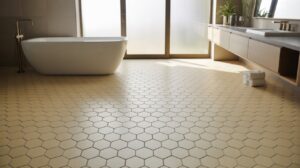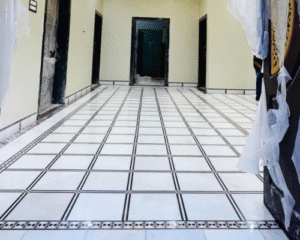Quartzite vs Granite – Which Stone is Best for Your Countertops?
Home renovations involve many decisions. Choosing the right material for your countertops or flooring is crucial. If you’re leaning towards natural stone, two popular options you’ve likely come across are quartzite and granite. Both offer remarkable beauty and durability, but they each have distinct characteristics that set them apart.
In this article, we’ll explore the key differences between quartzite vs granite, helping you make an informed decision. We’ll break down the pros and cons of each stone, so by the end, you’ll have a clearer understanding of which is the perfect fit for your home.
Quartzite vs Granite: Key Differences
When choosing between granite vs quartzite, it’s important to know their differences in looks, strength, upkeep, and price. Each of these factors plays a critical role in determining which material is the best fit for your renovation project.
Quartzite vs Granite: Durability
Both granite and quartzite are incredibly durable, making them popular choices for high-traffic areas like kitchen countertops. However, when it comes to resistance to wear and tear, quartzite holds a slight edge over granite. This stone is formed under intense heat and pressure, making it harder and more resistant to scratches. If you’re looking for a material that can withstand heavy use without showing signs of damage, quartzite is the more robust option.
Granite is also highly durable and heat-resistant but is more prone to minor chipping over time compared to quartzite. However, both stones will serve well in the long term with proper care.
Granite vs Quartzite: Appearance
One of the most notable differences in the quartzite vs granite debate is their appearance. Quartzite often mimics the elegant veining patterns of marble, making it a popular choice for those who want a sophisticated, high-end look. Its soft, sweeping veining is frequently mistaken for marble but offers greater durability.
On the other hand, granite features bold, granular patterns with a more distinct and varied color palette. You’ll often find specks of black, white, red, and green in granite slabs, giving it a more eye-catching, vibrant appearance. If you prefer a striking and natural look, granite may be the ideal choice for your space.
Granite vs Quartzite: Maintenance
Maintenance is a crucial factor when choosing natural stone for your home. Quartzite countertops generally require less sealing and are more resistant to staining compared to granite. Although both stones need periodic sealing to maintain their resistance to liquids, quartzite is less likely to absorb oils and spills, making it slightly easier to maintain.
Granite, while durable, can be more porous depending on the slab you choose, requiring more frequent sealing to prevent stains from setting in. With proper sealing, however, granite countertops are extremely easy to maintain.
Quartzite vs Granite Cost
When comparing quartzite vs granite price, quartzite typically comes out as the more expensive option. The price of quartzite ranges from $70 to $200 per square foot installed, depending on the quality and rarity of the stone. This is largely due to quartzite’s complex extraction and refinement process, as well as its scarcity.
Granite, on the other hand, is more readily available and can be found at lower price points, usually ranging from $40 to $100 per square foot installed. If budget is a concern, granite offers an excellent balance of beauty and affordability.
Quartzite vs Granite: Pros and Cons
Pros and Cons of Quartzite
Quartzite has become one of the most sought after natural stones are well worth for modern kitchens and bathrooms, especially for homeowners looking for a marble-like appearance without the softness and high maintenance of actual marble. Let’s take a closer look at the pros and cons of quartzite to help you decide if it’s the right choice for your renovation.
Pros of Quartzite
Extremely Durable
One of the standout features of quartzite is its impressive durability. Formed from sandstone and subjected to intense heat and pressure, quartzite is one of the hardest natural stones available. This makes it highly resistant to scratches, making it perfect for busy kitchens and high-traffic areas. If you’re looking for a stone that can handle everyday wear and tear, quartzite is a natural option.
Natural Beauty
Quartzite’s natural beauty is undeniable. With its soft, sweeping veining patterns, it offers a look similar to marble but without the high maintenance. It comes in a range of light, neutral tones that fit well with various interior styles, especially modern and minimalist designs. Its natural beauty is what makes quartzite countertops so popular in contemporary kitchens and bathrooms.
Resistant to Heat and Stains
Another major advantage of quartzite is its resistance to both heat and stains. Quartzite can withstand high temperatures, making it an ideal material for kitchen countertops where hot pots and pans are frequently used. Additionally, it’s less porous than some other natural stones, so it’s more resistant to staining from common kitchen spills like coffee, wine, and oils, as long as it’s properly sealed.
Cons of Quartzite
Higher Price
One of the downsides of quartzite is its cost. It is typically more expensive than granite when it comes to quartzite vs granite price comparison. Moreover, due to its rarity and the complex process of extracting and refining it. Prices for quartzite countertops usually range from $70 to $200 per square foot installed, depending on the quality and availability of the stone. For homeowners on a budget, this may be a limiting factor.
Requires Regular Sealing
While quartzite is highly durable, it does require regular sealing to maintain its resistance to stains and etching. Without proper sealing, the stone can become vulnerable to liquids and acidic substances, which could dull finish over time. Most professionals recommend resealing quartzite countertops every one to two years, especially in areas with heavy use.
Pros and Cons of Granite
Granite has long been a favorite material for kitchen countertops and other home surfaces due to its durability, classic appeal, and wide range of color options. While it has some drawbacks, granite remains a top choice for homeowners. Let’s explore the pros and cons of granite to help you determine if it’s the right option for your project.
Pros of Granite
Wide Range of Colors
One of the greatest advantages of granite is the variety of colors and patterns available. From light, subtle hues to bold, dark tones with intricate veining, granite offers something for every design choice and preference. This versatility allows homeowners to find a color and pattern that perfectly complements their interior style, whether it’s modern, traditional, or rustic.
Durable and Heat-Resistant
Granite is known for its exceptional durability. It is highly resistant to scratches, chips, and heat, making it a great choice for high-traffic areas like kitchens. You can place hot pots and pans directly on the surface without worrying about damage, which adds to its practicality in everyday use.
Less Expensive than Quartzite
When comparing granite to quartzite, granite is the more affordable option. Prices for granite countertops typically range from $40 to $100 per square foot installed, making it a cost-effective choice for homeowners seeking a high-quality natural stone without the higher price tag associated with quartzite.
Low Maintenance
Granite countertops are relatively low maintenance. While it’s recommended to reseal them periodically, typically once a year, granite does not require special cleaning products. A mild soap and water solution is sufficient for day-to-day cleaning, and its non-porous nature when properly sealed helps prevent staining.
Cons of Granite
Some Patterns May Look Busy
Although granite offers a wide variety of patterns, some options can be quite bold or “busy,” which might not appeal to everyone. If you’re seeking a more subtle or uniform appearance, granite’s granular and heavily patterned designs may not be the best fit for your aesthetic preferences.
Visible Seams on Large Installations
Another potential downside of granite is that seams may be visible, particularly on larger installations. While skilled fabricators can minimize the appearance of seams, they can still be noticeable in certain lighting or with specific patterns. This might be a concern for homeowners aiming for a seamless look.
Quartzite vs Granite Kitchen Countertops: Which is Right for You?
When it comes to choosing the perfect stone for your kitchen countertop, both granite vs quartzite are excellent investments that offer durability and style. Each option has unique characteristics that make it well worth considering for your home renovation. Quartzite is known for its natural beauty and resistance to heat and scratches, while granite offers a wide range of colors and patterns with impressive durability.
At SF Marble Granite, we offer a diverse selection of both quartzite vs granite countertops, ensuring that you find the ideal material that suits your needs and aesthetic preferences. Whether you’re looking for stunning quartzite or classic granite, our team is here to help you make an informed choice and achieve the perfect look for your kitchen.








